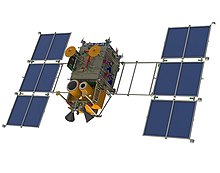Canopus-V
Kanopus-V (Kanopus volcano, Russian Канопус-В ) is the name of a series of Russian earth observation satellites.
construction
The three-axis stabilized satellites weighing between 450 and 490 kg are almost identical to the Belka 2 satellite and have a panchromatic camera with a resolution of around 2.1 m (1920 × 985 pixels, 520 to 850 nm) and a swath width of 23 km , a four-channel multispectral camera (1920 × 985 pixels, 460-520, 510-600, 630-690 and 750-840 nm) with a resolution of 10.5 m and a multispectral scanner MSU-200 (540 to 860 nm) with a Resolution of 25 m and a swath width of 250 km equipped for overview images. They should serve the purpose of earth exploration and the collection of data for improved maps, whereby the data should also be used for disaster control and agriculture. It was built on the basis of a satellite bus from the Russian company WNIIEM (originally: All-Union Science and Research Institute for Electromechanics). The avionics systems come from Surrey Satellite Technology in Great Britain. The planned service life is five years in each case. The energy supply is provided by a pair of solar cells, each consisting of three modules and enabling an average output of 300 watts in orbit. The space probe houses precise positioning and control systems with star and sun sensors; GNSS receivers as well as inertial measurement systems for position determination and reaction wheels as primary position actuators. The satellites have an onboard memory of 24 gigabytes, the data downlink is via an X-band communication system that operates between 8.048 and 8.382 GHz and achieves data rates of up to 300 megabits per second. The satellites are each placed in a sun-synchronous orbit with an orbit height of around 510 km.
Start list
| Surname | Start date (UTC) | Launcher | Launch site | COSPAR | Remarks |
|---|---|---|---|---|---|
| Canopus-V1 | July 22, 2012 6:42 am UTC |
Soyuz | Baikonur 31/6 | 2012-039A | Start with BKA, Zond-PP, exactView 1 and TET 1 |
| Canopus-V-IK | July 14, 2017 6:36 UTC |
Soyuz-2.1a / Fregat | Baikonur 31/6 | 2017-042A | Instead of the MSU-200, an MSU-IK-SR (multispectral scanner, with two bands in the infrared range 3.5–4.5 µm and 8.4–9.4 µm with a resolution of 200 m and a swath width of 2000 km) |
|
Canopus-V3 Canopus-V4 |
February 1, 2018 2:07 UTC |
Soyuz-2.1a / Fregat-M | Vostochny Cosmodrome | 2018-014A 2018-014B |
Start together with four S-NET -MicroSats from TU Berlin, four Lemur-2 -CubeSats from Spire Global and the D-Star ONE v1.1 Phoenix CubeSat from German Orbital Systems |
|
Canopus-V5 Canopus-V6 |
December 27, 2018 2:07 UTC |
Soyuz-2.1a / Fregat-M | Vostochny Cosmodrome | 2018-111A 2018-111B |
Launch together with 26 other satellites |
Individual evidence
- ↑ Spaceflight 101: Canopus-V - Canopus-V 3 & 4 | Spaceflight101 , accessdate: February 11, 2018
- ↑ raumfahrer.net: Soyuz brings satellite quintet into space , Günther Glatzel, July 22, 2012, 9:50 am
- ↑ Satellite Missions: Kanopus-V 1 - eoPortal Directory - Satellite Missions , accessdate: February 11, 2018
- ↑ WMO OSCAR | Satellite: KANOPUS-V4: WMO OSCAR | Satellite: KANOPUS-V4 , accessed February 11, 2018
- ↑ Spaceflight 101: Soyuz / Fregat Redeem Themselves on Third Vostochny Launch - Kanopus-V 3 & 4 | Spaceflight101 , accessdate: February 11, 2018
- ↑ RussianSpaceWeb.com: Soyuz rocket launches a 28-satellite cluster , access date: January 3, 2019
